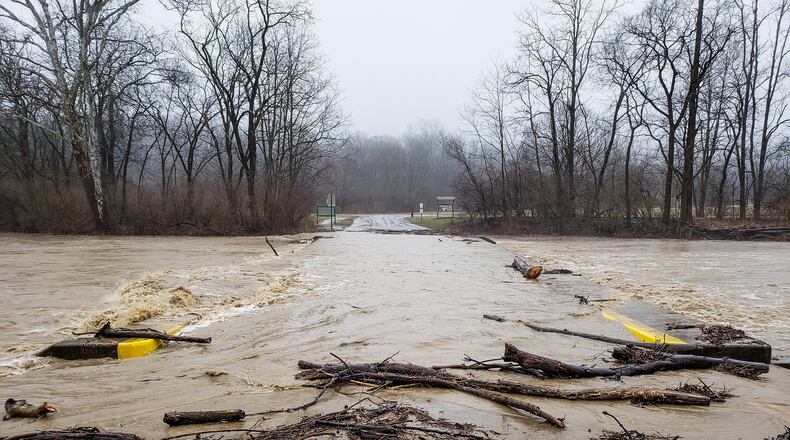“While top portion (of the ground) is thawed, there’s still a layer of it underneath that’s still frozen,” he said. “It can’t soak fairly deep.”
WEATHER: Check the weather at Journal-News.com
So when the rainwater can’t soak into the ground, it runs off into the streets, storm and sewer systems, and waterways.
About 1 1/2 inches of rain fell between early morning and midday Wednesday, and Astifan said by tonight another 1 1/2 inches should fall in many areas.
It will take about a half day for flooded brooks and creeks to clear out, and about a day for the water level to drop for larger waterways, like the Little Miami and Great Miami rivers. High water in the Ohio River could take several days to drop, he said.
The rain system that moved into Southwest Ohio and the Miami Valley “stalled” and it will take a cold front, which will come tonight to push it out.
The overabundance of rainwater is putting water and sewer systems to the test as it treats wastewater. While stormwater isn’t treated, it does get into the system during high rainfall events.
Butler County Water and Sewer Department Director Martha Shelby said on Wednesday the Upper Mill Creek wastewater plant is peaking at capacity, which is at 40 million gallons per day. Its LeSourdesville plant in Lemon Twp. is at about 65 percent capacity, treating 45 million gallons a day. Its capacity is at 70 million gallons per day.
Shelby said there is no surcharging at either plant “and everything’s doing well.”
WEATHER: Just how cold did it get this month in Butler County?
“We don’t have a combined system, and even though we’re doing our best to keep storm water out we’re still getting some storm water in the system,” she said.
Fairfield Public Utilities Director Adam Sackenheim said the wastewater treatment plant, and the Broadview lift station, is being staffed 24 hours a day for the next couple days to ensure flooding in the city doesn’t happen.
“The ground is just so saturated,” he said. “There’s just nowhere for (the rainwater) to go.”
The wastewater treatment plant on Groh Lane is usually staffed 16 hours a day over two shifts. However, the extra shift is added to monitor the Broadview lift station during wet weather events.
Sackenheim said the lift station was built about a decade ago to prevent basement and home flooding.
The wastewater treatment plant is rated to treat up to 10 gallons of effluent a day and has the capacity to treat 20 million gallons a day, Sackenheim said. On an average weather day, it treats around 5 million gallons, he said.
The city was treating close to its capacity of 20 million gallons a day rate as of midafternoon Wednesday, and utilized its three dry lagoons, which have a collective 10 million gallon capacity.
Astifan said the public should watch out for pooling water in roadways over the next day or two, and areas prone to flooding.
About the Author

